![65 Years of Innovation and Experience [default]](https://www.robbinstbm.com/wp-content/uploads/2017/04/Side-Bar-Blue-Blocks_70-Years.jpg)
UNA SOLUCIÓN PARA CADA SITUACIÓN: EXPLORE NUESTRA BASE DE DATOS DE PROYECTOS
Mapa de proyectos
FEATURED PRODUCT: CROSSOVER MACHINES
NUESTRA HISTORIA
Un legado de innovación
INFORMACIÓN ACTUALIZADA
Noticias y medios
NUEVAS PERSPECTIVAS EN EL SECTOR
Lea el blog de Robbins
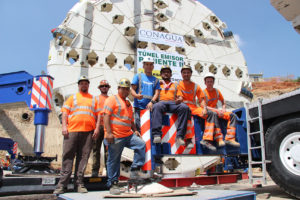 A Robbins Crossover (XRE) TBM was chosen to bore a 5.8 km (3.6 mi) tunnel as part of Mexico City’s wastewater management efforts, making it the first Crossover machine to bore in North America. The 8.7 m (28.5 ft) diameter machine includes features of both a hard rock single shield and an EPB in order to “cross over” into vastly different types of ground. Once complete, the tunnel will prevent flooding in urban areas and will convey sewage to the area’s first wastewater treatment plant, affecting the lives of 2.1 million people.
A Robbins Crossover (XRE) TBM was chosen to bore a 5.8 km (3.6 mi) tunnel as part of Mexico City’s wastewater management efforts, making it the first Crossover machine to bore in North America. The 8.7 m (28.5 ft) diameter machine includes features of both a hard rock single shield and an EPB in order to “cross over” into vastly different types of ground. Once complete, the tunnel will prevent flooding in urban areas and will convey sewage to the area’s first wastewater treatment plant, affecting the lives of 2.1 million people.
The tunnel path travels through a mountain with cover as high as 170 m (560 ft), through fault zones and in a section with cover as low as 8.0 m (26.2 ft) above the tunnel crown. Much of the tunnel consists of andesite rock with bands of tuff, and softer material in fault zones as well as an 874 m (2,870 ft) long section in soft ground at the end of the tunnel.
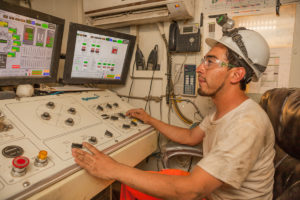 The Robbins XRE TBM features components like a convertible cutterhead that can be changed from a Hard Rock to EPB design, a removable belt conveyor and screw conveyor, and multi-speed gearboxes to increase torque for tunneling through difficult ground. Breakout torque is one way that the shielded TBM can propel itself through fracture zones without becoming stuck—multi-speed gear boxes can be activated to achieve high torque at a low speed, similar to how an EPB operates. With multi-speed gear boxes, the cutterhead can be freed in bad ground where it might otherwise become stuck. In hard rock, the TBM can operate in a standard low torque, high RPM mode.
The Robbins XRE TBM features components like a convertible cutterhead that can be changed from a Hard Rock to EPB design, a removable belt conveyor and screw conveyor, and multi-speed gearboxes to increase torque for tunneling through difficult ground. Breakout torque is one way that the shielded TBM can propel itself through fracture zones without becoming stuck—multi-speed gear boxes can be activated to achieve high torque at a low speed, similar to how an EPB operates. With multi-speed gear boxes, the cutterhead can be freed in bad ground where it might otherwise become stuck. In hard rock, the TBM can operate in a standard low torque, high RPM mode.
The Crossover XRE has other strategies in its arsenal to deal with difficult ground. The unique TBM was designed to bore below several valleys with expected water inflows. In the event of a high water inflow, a guillotine gate located on the muck chute is able to seal off the mixing chamber from the rest of the machine. In this way the TBM can passively hold high water pressures while the crew takes measures to dewater and consolidate ground.
The machine is equipped with continuous probe drilling, with a wide drilling range to investigate ground ahead of the machine. In addition to the standard probe drill, a canopy drill provides another ring for grout drilling or forepoling close to the cutterhead and in the top 120 degrees of the tunnel, while a second probe/grout drill is located further back on the machine, allowing two different patterns of holes.
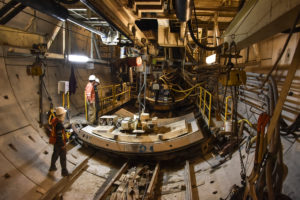 The Crossover machine was launched in August 2015 in a hard rock configuration and mounted with 20-inch diameter disc cutters—a risky move given that the first sections of tunnel were in softer soils before the TBM hit more solid rock. The machine’s advance rates picked up quickly, with project records set in December, and again in January after the machine achieved a best day of 42.8 m (140 ft) and a best week of 185.1 m (607 ft).
The Crossover machine was launched in August 2015 in a hard rock configuration and mounted with 20-inch diameter disc cutters—a risky move given that the first sections of tunnel were in softer soils before the TBM hit more solid rock. The machine’s advance rates picked up quickly, with project records set in December, and again in January after the machine achieved a best day of 42.8 m (140 ft) and a best week of 185.1 m (607 ft).
Early in 2016 the TBM hit the first of several contact zones, a 30 m (98.4 ft) wide fault of fractured and blocky rock. While the excavation through the contact zone was slow going, progress picked up again in the more competent andesite rock. After an intermediate breakthrough in March 2016 into an 80 m (262.5 ft) deep shaft followed by inspection and maintenance, the TBM continued on.
By June 2016, the TBM was boring in fairly competent rock and had achieved two national records for TBM advance—one for excavating 57 m (187 ft) in one day and another for boring 702.2 m (2,303.8 ft) in one month.
While boring in fractured andesite rock in autumn 2016, the TBM encountered a naturally occurring cavern believed to be the result of either a rock fall in a transition zone, or an old, underground lake body that had eroded the rock away. The cavern was approximately 90 cubic meters in size, including about 57 cubic meters of unstable floor area. The TBM was stopped and immediate measures were taken to fill the cavern.
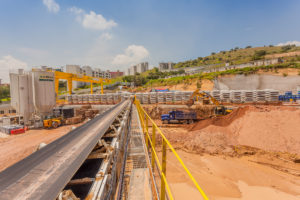 By the end of October 2016, the TBM had reached the final section of soft ground. In this final zone of low cover, the distance from the top of the tunnel to the surface is less than 1.5 times the machine diameter, and the ground has the consistency of reconsolidated soil. The residential area meant that subsidence had to be kept to a minimum, and the decision was taken to convert the Crossover machine to EPB mode.
By the end of October 2016, the TBM had reached the final section of soft ground. In this final zone of low cover, the distance from the top of the tunnel to the surface is less than 1.5 times the machine diameter, and the ground has the consistency of reconsolidated soil. The residential area meant that subsidence had to be kept to a minimum, and the decision was taken to convert the Crossover machine to EPB mode.
Conversion of the TBM to EPB mode required multiple steps. The conversion process started with the modifications of the cutterhead, adding the piping for the new foam lines, changing the hard rock bucket lips into the EPB soft ground scrapers, and removing the muck buckets characteristic of a hard rock TBM. The removable plates on the cutterhead were changed to alter the opening ratio from Hard Rock optimized to EPB optimized (from 7.9% to 18.95%). Other steps include installing mixing bars into the bulkhead, switching out the TBM belt conveyor to a screw conveyor, altering the fluid system for EPB additives, and installing tails seals and articulation seals for pressurized boring.
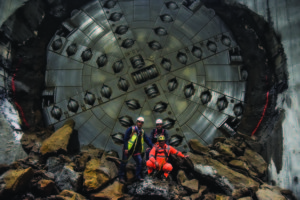 The machine was completely converted and ready to bore at the start of 2017. The machine started its latest section with about 18 m (59 ft) of cover, which was reduced due to the ground slope to just 12 to 14 m (39 to 46 ft). By March 2017, the TBM had performed well, with just 517 rings (about 775 m, 2.543 ft) left to bore. The TBM’s best day of production in soft ground was 13 rings (19.5 m, 64 ft) in only one 12-hour shift—impressive results despite the limited boring hours due to the residential area above. Final breakthrough occurred in late May 2017.
The machine was completely converted and ready to bore at the start of 2017. The machine started its latest section with about 18 m (59 ft) of cover, which was reduced due to the ground slope to just 12 to 14 m (39 to 46 ft). By March 2017, the TBM had performed well, with just 517 rings (about 775 m, 2.543 ft) left to bore. The TBM’s best day of production in soft ground was 13 rings (19.5 m, 64 ft) in only one 12-hour shift—impressive results despite the limited boring hours due to the residential area above. Final breakthrough occurred in late May 2017.

 Close
Close